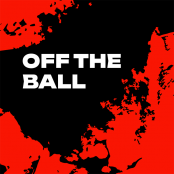England's 57-15 victory over Ireland from last August lingers over this weekend's matchup at Twickenham. The Irish players will look to that game for motivation, but how much should they take from the performance itself?
Ireland would prefer to forget their last two meetings with England. In last year's Six Nations, Robbie Henshaw played fullback as England picked Joe Schmidt's side apart with relative ease. There was a physical dominance in that game that carried over into the August meeting in Twickenham. Although it was only a warm-up game, that record-shattering 57-15 loss hurt as much as any of the World Cup displays.
Johnny Sexton didn't play that game. James Ryan didn't either. Rory Best and Rob Kearney did. Schmidt was still the head coach and Ireland will have a completely different bench this Sunday. It was the first game off a tough training camp in Portugal for most of the players involved.
There are many reasons to write that game off and not mention it this week. But emotionally the players can't. And the Irish coaching staff shouldn't either.
For all the reasons to ignore the result, 10 of the players who started that game will start Sunday's game. It's easy at this point to put the blame for every failing on Joe Schmidt, but Andy Farrell's defence failed that day. Farrell hasn't changed his defensive system, at least not dramatically. The system wasn't really at fault against England in August either. Ireland allowed England to score 50 points because of individual errors.
Those can't be repeated on Sunday.
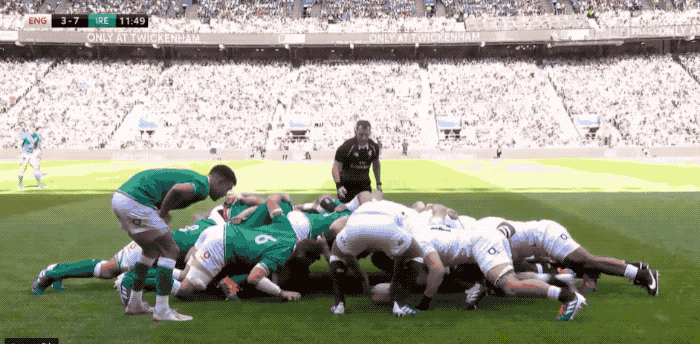
England's first try came straight off a strike play. Joe Cokanasiga ran in untouched in the right corner after a backline move set him free. Jacob Stockdale saw some criticism for stepping inside and looking to stop the ball prematurely, but Stockdale was forced into that action by what happened inside of him. The mistake on this play actually came from Conor Murray.
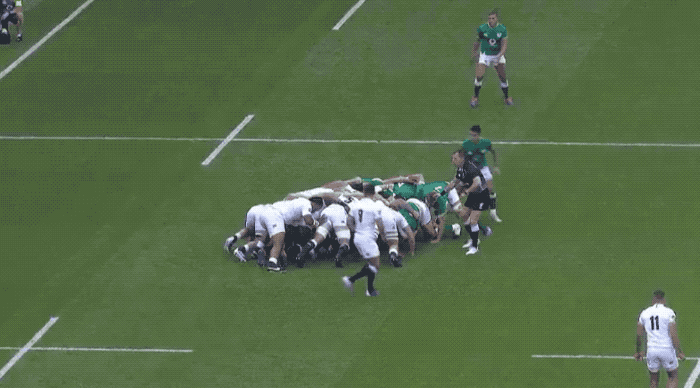
Scrum halves always line up to the left side of the attacking team on scrums. Therefore, the best attacking platform is a scrum on the left side of the field outside of the 15-metre line. That's exactly where this scrum is. Had England held the scrum straight or turned the Irish pack to the outside, they could have trapped Murray on the blindside. Instead, the Irish pack do a good job of turning the scrum to the outside and Murray follows opposing scrum half Ben Youngs when he leaves the back of the scrum.
Murray is initially in a great position, but he sees Billy Vunipola pick up the ball and panics. He sprints back to the blindside, thinking Vunipola is going to carry. Instead, Vunipola passes the ball to Youngs. Not only did Murray take himself out of the play, but Jordan Larmour made the same read and ran to the blindside too, that took him out of the play.
So before the ball has even reached the first receiver, two backs are out of the play. Josh Vander Flier, Ireland's openside flanker, has to check Vunipola isn't running the ball off the scrum, so he is also kept out of the play despite Ireland turning the scrum to help him get to first receiver.
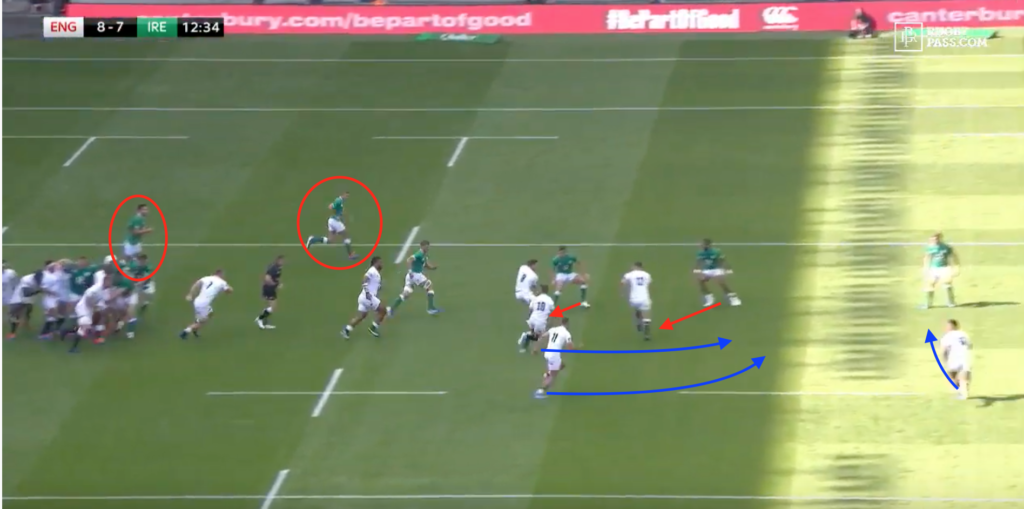
Ireland's defence is three men down off the base of the scrum. England's attack detached its scrum half so he joins the backline. They also brought their blindside winger, Johnny May, around the back to run on the outside shoulder of out-half George Ford. Inside center Owen Farrell runs a crash ball line into the gap between Ross Byrne and Bundee Aki, drawing Aki out of position. That leaves Garry Ringrose alone in space with Ford, May and Manu Tualagi coming into his channel.

Tualagi mirrors Farrell's angle to force Ringrose to step inside. Ford throws the ball out the back to May. With both of his centres stepping inside, Stockdale is forced to try and cut the ball off at the source. England have a three-on-two overlap outside. The depth that May catches the ball at affords him the space to get the ball out before Stockdale can cut off the attack. A simple pass from Eliot Daly beats Rob Kearny and Cokanasiga runs in the easy score.
If you revert to the first gif of the play, you can see Jordan Larmour make a desperation tackle attempt before Cokanasiga reaches the try line. Had Murray just stayed on the blindside, Larmour would have reached Cokanasiga earlier to prevent the try.
When Youngs has the ball, he has six attacking players outside of him. Ireland have only four defenders. It's that simple.
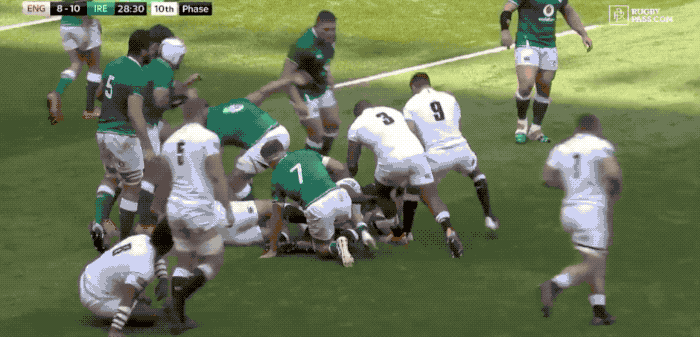
Tualagi is a terror. He's essentially Billy Vunipola playing centre. For England's second try, Vunipola hits a crash ball at speed and perfectly attacks the gap between Ringrose and Healy. He gains forward momentum to provide front-foot ball on the ensuing phase. Aki was watching the ball, slow to slide outside. That left Stockdale alone with multiple England defenders to cover. Stockdale should have stayed outside, but the gap between he and Aki is so large that it's understandable he felt the need to try and cut the ball off.
England move the ball well for another easy-looking score. It must be noted Murray was down injured during this phase, reducing Ireland to 14 men in defence.
Try number three had three key moments.

An unforced Jacob Stockdale knock-on gave England a scrum near midfield. The aforementioned injury to Murray put Luke McGrath on the field. McGrath is the first at fault in this sequence. He loses the run of himself during the scrum, dropping in behind the scrum itself when Youngs never threatened to go to the blindside. Kearney stays in the backfield because of the position of the scrum, that means the Irish backline is relying on McGrath to account for the first receiver on the open side.
McGrath being late to react from his initial poor position forces the rest of the defensive line to continue to drop off Tualagi until he has caught up. This gives England a foothold in Irish territory to build from.
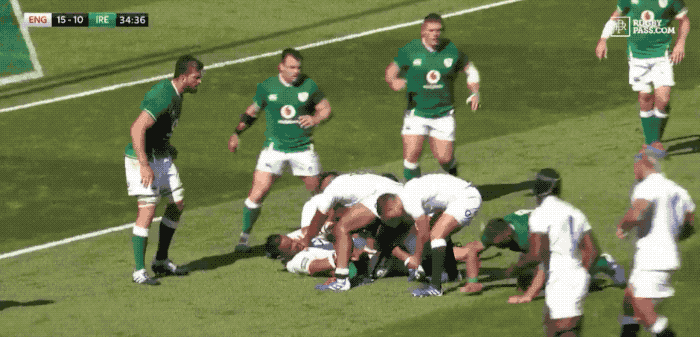
Two phases later, Ford kicks the ball to the Ireland five-metre line. Rory Best wildly misses his throw on the lineout, giving England the platform to pressure the Irish try line. A key moment during this sequence is Maro Itoje running right over Ross Byrne. Johnny Sexton is a tenacious defender. He's obviously not a dominant tackler, but he's one of the more physical out-halves in the world. Byrne was the complete opposite in this game. England targeted and abused him throughout the first half to gain good yardage.
None of McGrath, Best or Byrne will start this weekend, only Byrne has a chance to feature off the bench. Those players set up the opportunity, but it's Bundee Aki, who will start this week, who was ultimately at fault for the try.

From the very start of this play, Aki is setting up to ambush the number eight. It's as if he anticipated Vunipola taking the ball off the base and ignored everything that happened after the scrum began. Instead of staying disciplined in his position outside the referee, he inexplicably sprints past the referee's inside shoulder even after Vunipola is flipping the ball out to his scrum-half. All Aki does is take out Josh Vander Flier.
Aki's mistake creates an overlap. Stockdale is in a lose-lose position. He hopes Tualagi throws the ball without looking, but the English centre shows good awareness to step forward and score. Aki is typically one of Ireland's better defenders, this was a moment of insanity.
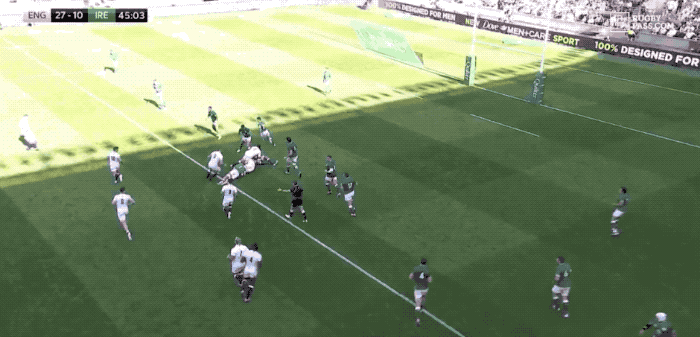
After Rory Best overthrew Iain Henderson on a defensive lineout, England set up a platform in the Ireland 22. Jack McGrath has an Aki moment when he doesn't properly diagnose the position of the attacker directly across from him. Maro Itoje takes advantage with a great line but he goes through a wide-open lane that shouldn't have existed. McGrath has since lost his backup role to Munster's Dave Kilcoyne.
That was the try that set the blowout in motion. Cian Healy and Conor Murray had gone off injured by this time and a large portion of the players on the field who were on the field aren't currently involved with the Irish squad.
England's attack that day was outstanding. They didn't make mistakes and the timing in attack was near-perfect. However, this weekend's game is a completely different proposition for them too. Tualagi is there but Vunipola isn't. Without his threat off the base of each scrum, the strike plays won't be as effective. Presumably, Ireland's lineout with Ryan and Rob Herring in for Jean Kleyn and Best will be more of a threat. England shouldn't be able to expect free attacking platforms off Irish defensive lineouts.
Putting Ryan back into the defensive line will be huge for Ireland. Having Robbie Henshaw's physicality and defensive mind in place of Ringrose at outside centre will be big too. But maybe the most important defensive change will be Jordan Larmour in for Rob Kearney.
When England were running Ireland ragged in the first half, Kearney was beaten in space for significant gains on three occasions. His lack of speed around the field was notable and his lack of agility to change direction in tight spaces was costly. Larmour isn't a defensive fullback, but he's a good defender and has a major athleticism advantage over Kearney.
The physical advantage that the English players had in that matchup allowed them to successfully offload the ball on a regular basis. That gameplan shouldn't work against this Ireland squad.
Jeremy Guscott may well be right in accusing Irish fans of being too pessimistic in their outlook. Ireland enter this game in position to potentially win a grand slam. They're not massive underdogs. The last two matchups aren't indicative of where these teams are right now. So long as the Irish players don't repeat their unforced errors from August, they should have a good chance of winning the game.
Everyone’s in the Team Of Us.
Vodafone. The Official Sponsor of the Irish Rugby Team.
Subscribe to Off The Ball's YouTube channel for more videos, like us on Facebook or follow us on Twitter for the latest sporting news and content.
